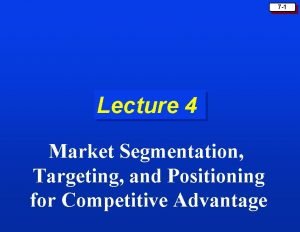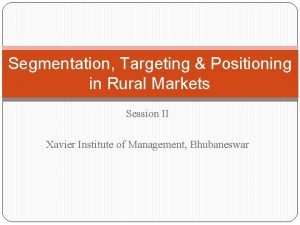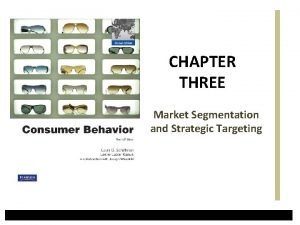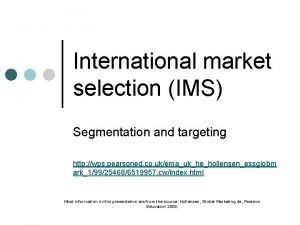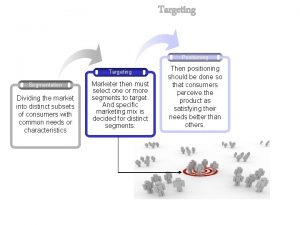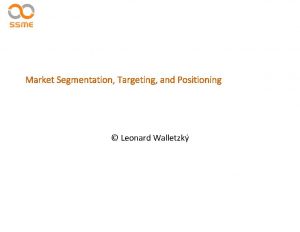International market selection IMS Segmentation and targeting http













- Slides: 13

International market selection (IMS) Segmentation and targeting http: //wps. pearsoned. co. uk/ema_uk_he_hollensen_essglobm ark_1/99/25468/6519957. cw/index. html Most information in this presentation are from the source: Hollensen, Global Marketing 4 e, Pearson Education 2008.

IMS and segmentation ¢ ¢ ¢ Which market/s to enter? (cca 200 countries) What the „right market“ to enter is? What is „international market“? Ø 1. a country or a group of countries Ø 2. a group of customers with nearly the same characteristics (from several countries) Market opportunities: ü Existing markets ü Latent markets – recognized potential ü Incipient markets – market does not exist now indication/trends – future emergence of need

Uppsala model of the internationalization process INTERNATIONAL MARKET SELECTION INTERNATIONAL MARKET SEGMENTATION THE FIRM v. Degree of internationalization and overseas experience v. Size/amount/quality of resources v. Type of industry/natue of business v. Internationalization goals v. Existing networks of relationships THE ENVIRONMENT v. International industry structure v. Degree of the internationalization of the market v. Host country: üMarket potential üCompetition üPsychis/geographic distance üMarket similarity

Market screening (segmentation) model the firm environment Selection of the relevant segmentation criteria Development of the appropriate segments Screening of segments to narrow down the list of markets/countries Choice of target markets Microsegmentation: develop segments in each qualified country or across countries Market entry – how many markets, when, how - sequences

Segmentation criteria ¢ High degree of measurability, accessibility and actionability ¢ Measurability = the degree to which the size and purchasing power of resulting segments can be measured Accessibility = the degree to which the resultung sgments can be effectively reached and served Profitability/substantiality = the degree to which the segments are sufficinetly large and/or profitable Actionability = the degree to which segments has sufficient resources to formlate effective mmarketing programmes and make things happen General characteristics Geographic – PRIMARY - clustering Language – communication + patterns of thoughts Political factors – regulations, stimuli… Demography – age, gender… Economy – development, income… Industrial structure – Poland Finland? Technology Social organization – family, classes… Religion Education – literacy, knowledge, skills… ¢ ¢ ¢ Specific characteristics Cultural Lifestyle Personality Attitudes and tastes ¢ Low degree of measurability, accessibility and actionability (but high degree of relevance)

Screening of markets/segments – preliminary screening According to external criteria (= the state of market) - macrooriented methods: ¢ A) PESTLE + 5 (6) comp. Forces (PORTER) ¢ B) RISK Business Environment Risk Index (BERI) http: //www. beri. com/ (e. g. ¢ political stability, economic growth, laour costs/productivity, communications, profess. services and contractors…) The Goodnow and Hansz temperature gradient – country´s environmental factors rated on a temperature gradient (…legal barriers, cultural unity…) ……The Economist, own risk evaluation… ¢ C) shift-share approach – „…the average growth rate of imports for a particular product for a basket of countries is calculated, then each country´s actual growth rate is compared with the average growth rate. The difference identifies growing or declining markets…“ Hollensen, p. 252) http: //www. andrew. cmu. edu/user/jp 87/URED/readings/Shift_Share. pdf

Screening of markets/segments – preliminary or/and fine-grained screening – clustering example (Western European market)

Screening of markets/segments – finegrained screening - e. g. GE matrix – market attractiveness/competitive strength Market/country attractiveness ¢ ¢ ¢ ¢ ¢ Market size and growth (total and segments) Buying power Market seasons and fluctuations Average industry margin Competitive conditions (concentration, intensity, entry barriers…) Market prohibitive conditions and government regulations Infrastructure Economic and political stability Psychic distance Country- of - origin image Competitive strength ¢ ¢ ¢ Market share Marketing ability and capacity (country specific know-how) Products fit to market demand Price Contribution margin Image Technology position Product quality Market support Quality of distribution and service Financial resources Access to distribution channels

The market attractiveness/ competitive strength matrix

SEGMENTING MARKETS WITHIN COUNTRIES ¢ ¢ ¢ Similar structure of demand customer/consumer habits Demographic/economic factors Lifestyles (Activities, Interests, Opinions) Costumer/consumer motivations Buyer behaviour – e. g. benefit sought, loyalty patterns, information search behaviour, product characteristics required. . ¢ ¢ etc. CULTURAL AFFINITY ZONES – SOCIODEMOGRAPHICS CHARACTERISTICS – same anywhere?

Example of IMS process

Unilever´s global portfolio Product categ. H Product busin. H Mk. A CA MA – market attract. cheeses L H CA H Mk. A Ranieri H L CA L countries H N. America Europe Carte d´Or L regions L Solero Magnum Meal sauces Specialty chemicals H Frozen foods Mk. A detergents L H Icecream foods Mk/ SBU A brands Germany UK Mk. A Asia France CA – comp. Strength L. America H-high L L H L low Denmark CA L H Greece CA L

Ahold worldwide
 Steps in market segmentation
Steps in market segmentation Segmentation vs targeting
Segmentation vs targeting Customer segmentation targeting
Customer segmentation targeting Sony market segmentation, targeting and positioning
Sony market segmentation, targeting and positioning Sony market segmentation, targeting and positioning
Sony market segmentation, targeting and positioning Nokia market segmentation targeting and positioning
Nokia market segmentation targeting and positioning Market segmentation, targeting and positioning
Market segmentation, targeting and positioning Segmentation of rural market
Segmentation of rural market Benefits sought segmentation
Benefits sought segmentation Differentiated undifferentiated and concentrated marketing
Differentiated undifferentiated and concentrated marketing Consumer rooted segmentation
Consumer rooted segmentation Market segmentation and selection
Market segmentation and selection Nivea positioning statement
Nivea positioning statement Positioning involves meeting consumers lower performance
Positioning involves meeting consumers lower performance






